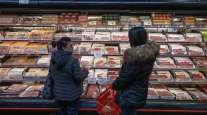Spending Rises Less Than Forecast as Americans Boost Savings

Consumer spending rose less than forecast in March, wrapping up the weakest quarter in a year for the biggest part of the U.S. economy even as incomes accelerated.
Purchases picked up 0.1% after a revised 0.2% gain in February, Commerce Department figures showed Friday. The median forecast in a Bloomberg News survey called for a 0.2% advance. Incomes increased 0.4%, matching January as the biggest gain since June.
A tempering of household purchases for the last three quarters has surprised economists given the favorable backdrop of low inflation, job gains and cheap borrowing costs. Faster wage growth may be needed to help encourage American consumers to spend more freely and jump-start an economy coming off its weakest performance in two years.
“Consumption ended the quarter on a very soft footing,” said Millan Mulraine, deputy head of U.S. research and strategy at TD Securities USA in New York, who correctly projected the gain in spending. “It’s a weak hand-off to the second quarter. There’s nothing in this report to suggest a strong imminent pickup in spending” and “the inflation story is also benign.”
Projections for March spending ranged from unchanged to a gain of 0.4%. The previous month’s reading was initially reported as a 0.1% increase.
The Bloomberg survey median called for incomes to rise 0.3%. February was revised to a 0.1% gain from a previously reported 0.2% advance.
Disposable income, or money left over after taxes, increased 0.3% in March from the prior month after adjusting for inflation following a 0.2% gain in February.
The saving rate rose to 5.4% last month, the highest in more than a year. At $735.5 billion, the level of savings was the highest since December 2012.
In the first quarter, real disposable income rose at a 2.9% annualized rate after a 2.3% pace in the final three months of 2015. In January through March of 2015, it was running at a 3.9% clip.
Wages and salaries climbed at a 3.9% pace in the first quarter, the slowest pace in a year.
The report showed the price index tied to consumer spending increased 0.1% last month after falling 0.1% in February. From a year earlier, the gauge was up 0.8%. This inflation measure is preferred by Federal Reserve policy makers and it hasn’t met their target since April 2012.
Stripping out the volatile food and energy components, the price measure also rose 0.1% from the month before and 1.6% in the 12 months ended March.
With the one component of the Fed’s dual mandate — employment — on solid ground, signs that inflation is gradually accelerating toward the bank’s goal would be welcome. Such a development would provide some ammunition for members of the Federal Open Market Committee who’d like the central bank normalize interest rates sooner rather than later.
“Inflation is expected to remain low in the near term, in part because of earlier declines in energy prices, but to rise to 2% over the medium term as the transitory effects of declines in energy and import prices dissipate and the labor market strengthens further,” the FOMC said in an April 27 statement.
After adjusting for inflation, which generates the figures used to calculate gross domestic product, purchases were little changed last month after a 0.3% gain in February. Spending in March was held back by less demand for motor vehicles, according to the Commerce Department.
Purchases of durable goods, including automobiles, decreased 0.3% last month after adjusting for inflation, compared with a 0.4% gain in February. Outlays for non-durable goods, which include gasoline, rose 0.7% in March. Spending on services fell 0.1%.
The GDP report published Thursday showed the economy expanded from January through March at the slowest pace in two years as companies and consumers alike tightened their belts. GDP rose at a 0.5% annualized rate after a 1.4% advance in the fourth quarter.
Household purchases, which account for almost 70% of the economy, rose at a 1.9% annual pace last quarter, compared with 2.4% in the final three months of last year.




